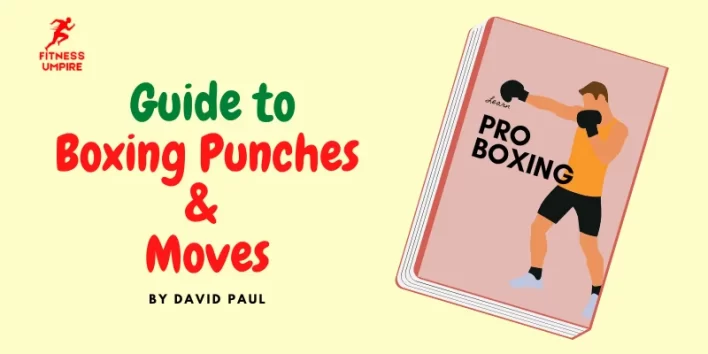
Learn the basic boxing punches and moves to elevate your training and technique. From jabs and hooks to uppercuts and footwork, this guide provides a comprehensive overview of the essential techniques. Develop power, speed, and accuracy as you master the building blocks of boxing.
Whether you’re a beginner looking to establish a strong foundation or an experienced boxer seeking to refine your skills, this guide will take your boxing game to the next level. Explore the art of boxing and unlock your potential in the ring. Let’s dive deep,,
Many thinks that boxing is simply throwing blows without any control or order, but in reality, this sport implies much more than that. Boxing is a historical game and with the passage of time the need to classify the punches has been given specific names. These terms are not only useful in professional fighting’s but is a great footprint for the learning of beginner boxers.
The classic and main basic punches in boxing are 4 i.e. the Jab, Cross, Hook and Uppercut. But according to various boxer its 6 by adding the sub clauses of hook and uppercut for a boxing combination.
For example, Hook and Uppercut are further divided that can be performed as a leading and rear strikes. I have briefly explained each punch with basic boxing moves in this article. Lets know
Basic Boxing Punches Break Down
The following punches are the basic as well as foundation of professional boxing. As a beginner boxer you must be familiar about the role of these 4 types of basic punches. Plus, you should also be familiar about the sub set of Hook and Uppercut which in total counting as a 6 basic boxing punches.
- Jab
- Cross
- Hook
- The Lead Hook
- The Rear Hook
- Uppercut
- The Lead Uppercut
- The Rear Uppercut
The Jab
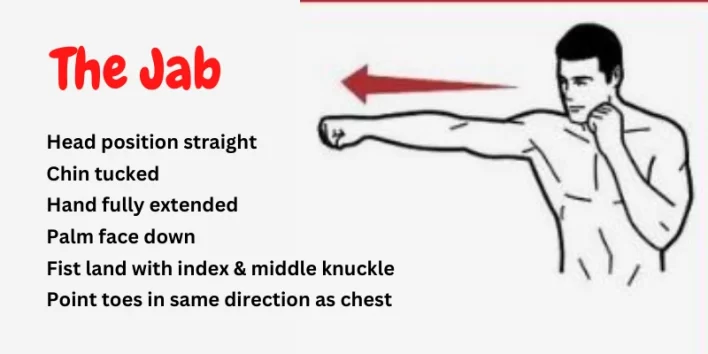
This punch can be delivered from various positions and is traditionally a straight punch with the main hand. During this process, power is usually gained by stepping in and out, rotating the hips, and then rotating the torso, shoulders, and wrists before hitting the bag or opponent in the ring.
The strike area without gloves is the knuckles of the index and middle fingers. Many professional boxers use the jab effectively in half jabs and half hooks by throwing from the hip.
The jab is flexible, fast and can strengthen your punch. People who are good at jabs feel calm, accurate and sparks of energy when hitting. The jab can be strengthened by combining proper timing with proper leg movement and effective angle.
Your jab must be powerful enough to stop your opponent from making combos. Always your jab should be ready to hit hard. In a defensive fashion, the jab creates space to keep your opponent away and distract them.
Its goal is to strike, distract, push, or even defend against an opponent’s blow. Unlike other punches and techniques in boxing, the jab is faster and longer. Also, it gives us a better chance of hitting the target.
To throw a jab, you must place yourself in an attacking position with your hands flush with your face and your arms fully extended to your skilled side – the side that is in front of you in boxer stance.
It is important that the wrist is turned and the fist is level when hitting. The shoulders also rotate and cover the chin. After the jab is complete, bend the elbow back to the defensive position.
The Cross
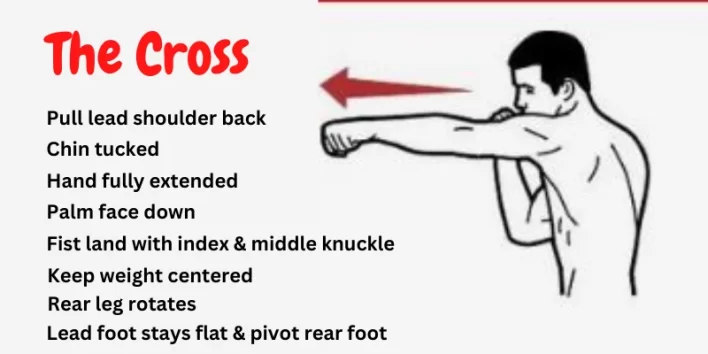
This is the boxer’s defensive stance, with the hands in the rear. Most of the time, the blow moves directly to the opponent’s face. It’s like aiming for the back shoulder and the outside of the chin to meet.
At the same time, the front hand should be placed in front of the face to protect the inside of the boxer’s chin. Some boxers move the torso and hips at the same time to create a greater impact of the movement.
Most fighters also call it a straight, and some say it complements the jab because it’s done with the opposite arm. Once an opponent is punched, the immediate impact is to get the full score.
It’s necessary to learn how to do a direct hit, or you’ll lose an undeniable advantage: tagging your opponent and knowing exactly where to hit him. The key to hitting an effective cross punch is to extend the inside of the arm.
The knuckle of the index finger should be at the same level as the inside of the shoulder. By not bending your arms, recovery – i.e. getting back to the starting position should be quicker so you can avoid counter-attacks from your opponent.
The Hook
Hook in boxing requires a lot of efforts but also can bring positive results if you performed it correctly. In every boxing fight, technique is the main factor, and the hook is in one of them. By using it well you can give more damage and get points due to its exertive force.
In the statistics and studies that have been done on boxing, the more damage you do to your opponent, the easier it is to win, a lot will depend on what strikes are used and when. The boxing situation is important for the hook to decide when to hit. It is a shaken blow, so if you used it at the right time when the opponent is weak, it can bring a positive outcome.
Instead of using this strike alone, it is preferable to use it in combination, between a simple strike and a boxing hook, or simply combine both hands to apply it.
The Hook must be carefully prepared when training. Knowing when to throw the hook ensures we get a round, or even a fight. The hook can be accomplished with both skilled and unskilled arms.
The Hook is further divided into two sub segments i.e lead hook and rear hook. These both types of hooks are almost the same with a little bit of difference in the positioning of foots but It can make a huge difference in boxing by generating extra power.
The Lead Hook
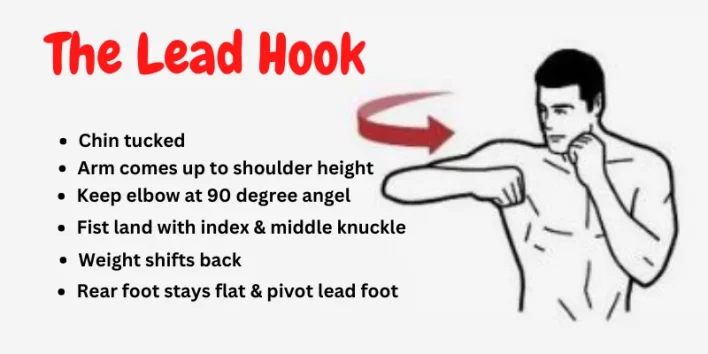
You can perform lead hooks based on your defender position. Your front arm should be bent and fist will land with index and middle knuckles, with your elbows at a 90-degree angle. Your arms should be shoulder-high, chin tucked, and upper body weight shifted back.
The lead hook depends mainly on the positioning of the foot. Your back foot should be fully on the ground, and the rotation should be through the front foot.
The Rear Hook
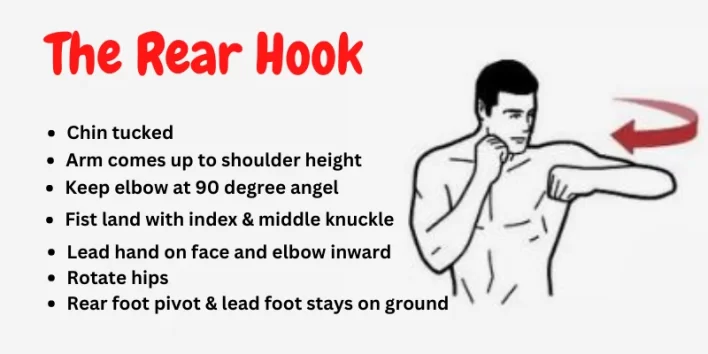
Similar to the lead hook, the rear hook can be done with the right or left arm, i.e. left or right, depending on your defensive stance. Tuck your chin and bend your elbows 90 degrees so your arms should reach shoulder height. The leading hand should remain on the face and elbows inward.
In a rear hook with a rotated hip, the front foot remains on the ground while the rear foot should be used for pivoting.
Important things to note for a strong and effective Lead or Rear Hooks are: –
- Success with your pivot:- The quality of your pivot increases the strength of your hook.
- Aim for Sensitive Areas:- Having a strong rear hook is useless without targeting the right area, like your hook falls on your opponent shoulder every time. In order to strike effectively, it must reach and hit key areas such as: jaw, liver, ribs, etc.
The Uppercut
The uppercut is one of the most important but most damaging punches in boxing. It’s also one of the most technically difficult to execute, and perhaps the most difficult to implement. It needs the same speed, accuracy and timing to deliver impact.
It is a powerful punch from the waist up, aimed at the opponent’s chin or various parts of the body, such as the kidneys, liver, nerve plexus, etc. Uppercuts are most commonly used in combat sports, but are not primarily used by professional fighters from a distance because they reduce power and carry some risk.
You can add various uppercut techniques to the game to suit various scenarios. It is most effective when the opponent cannot use it as part of a combination.
The uppercut is a good punch, but to really understand how it is used, and how to defend against it, you have to know a little bit about it. There are many advantages and disadvantages to using an uppercut, and we’ve listed them here.
This technique is so popular that many gyms go by the name “Uppercut.” The uppercut is one of the most iconic moves in boxing, and along with the jab, uppercut, and crossover, the uppercut is the most characteristic of all moves.
Mastering the uppercut in boxing is indeed a tough phase. Even professionals, with their precision, have a hard time getting uppercuts. However, the uppercut is not only the most overlooked move in boxing, but also the most misguided punch. Why?
It’s just that there isn’t much equipment to help practice and master the uppercut. Another reason is that its long-distance performance becomes a limitation. Boxers who prefer to fight from a distance find the uppercut an awkward move because it requires them to get closer to their opponent.
Another risk of uppercuts is exposing certain areas of the body itself, reducing the chances of defending and leaving the counter. However, when hit correctly, it is enough to knock an opponent down.
Look at today’s boxers, most of them are taught to keep their distance. They are specially trained to master shots such as passing and jabs because they land faster and easier. But that’s not the case with uppercuts. Because the uppercut is a staple in any serious boxer’s offensive arsenal, it’s as difficult to polish as it is to be.
Long-range uppercuts are possible, but they are very uncomfortable for most people and lack all the power associated with traditional uppercuts, which land on an almost vertical path.
This vertical path takes advantage of the body twist created by strong hips and legs. This power is greatly reduced once the fighter goes beyond a certain point to hook an opponent.
To launch an uppercut, it’s important to bend your knees slightly to increase power. The hips should be kept as low as possible and rotated as the skill arm is lowered to belly level. The blow ends when it hits the opponent’s jaw.
The lead uppercut
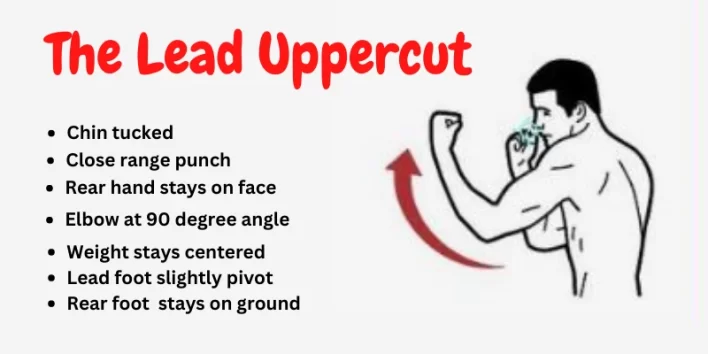
This is not just a punch, but a horrific blow in the boxing world. The most brutal knockout I’ve seen often, especially this one. This punch requires your energy and speed to score successfully. Also, since this punch plays an important role in winning a fight, you should always be careful to focus on your defense and ground positioning.
In leading uppercuts, especially at close range, keep your weight centered. For defense, your chin should be tucked and your face covered with your back hand. When punching, the main elbow is at a 90-degree angle. In a front uppercut, your front foot should turn slightly and your back foot will touch the ground.
The Rear Uppercut
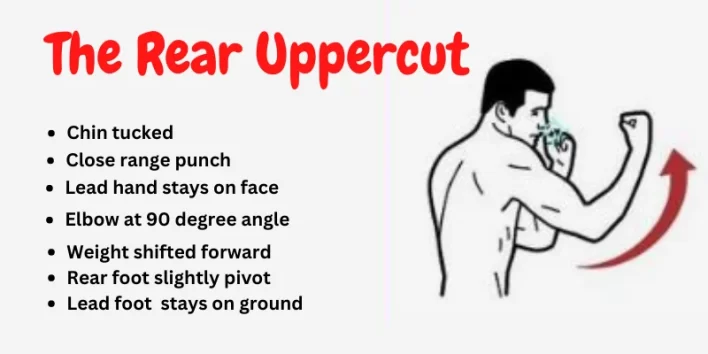
A rear uppercut can give you almost the same result as a leading uppercut. However, the positions of the hands and feet are slightly different. Rear uppercuts are more useful if your opponent is left-handed. However, this is purely an experience I share.
If you want to perform or practice a rear uppercut, your chin should be tucked in. For a closed shot, your lead hand should remain in front of your face and elbow at 90 degrees. Your weight should move completely forward. Your back foot will be used for rotation, while your front foot should remain fully on the ground.
The Number System and Practice of Basic Punches in Boxing
Many novice boxers often start boxing without discipline, which often leads to injuries from their unbalanced blows. In order to evenly distribute your punching power and technique, there is a well-defined method called punching combinations.
These boxing combos are designed to make it easy for every boxer to learn and practice. The more you will practice according to the pre-determined number of punch formulas, the more impactful results it will give you.
These punches are numbered from 1 to 6 in a conventional manner that anyone can easily memorize and practice in a balanced way: –
- Odd numbers 1, 3 and 5 for right hand punches
- Even numbers 2, 4 and 6 are used for left hand punches
First for beginners, it is important to memorize and practice these punches according to their layout, and then move on to some basic boxing combos. These combinations are made up of the basic four (expanded to six) types of punches we discussed above.
All you have to do is use a similar punching system and combine various punches as you practice. Making and practicing these combos are easy but combinations made by professionals have the essence of clear advantage.
List of Boxing Combinations
Below is a list of some good and basic boxing combos that will help you a lot as a beginner as well as a home workout routine.
- 1,2 = Jab, Cross
- 1,2,3 =Jab, Cross, Left Hook
- 1,4 = Jab, Right Hook
- 2,3 = Cross, Left Hook
- 2, 3, 2 = Cross, Left Hook, Cross
- 6, 3 = Right Uppercut, Left Hook
- 5, 2 = Left Uppercut, Cross
- 1, 2, 5* = Jab, Cross, Left Uppercut to the body
- 5, 6, 3 = Left Uppercut, Right Uppercut, Left Hook
- 1, 1, 2 = Jab, Jab, Cross
- 1, 2, 1 = Jab, Cross, Jab
- 3, 4 = Left Hook, Right Hook
- 3, 4 = Left Hook to the body, Right Hook
- 3, 4, 3, 2 = Left Hook, Right Hook, Left Hook, Cross
- 1, 2 = Jab, Cross to the body
How to Do Basic Boxing Punches Step by Step
As we discussed above, there are six basic boxing combinations, and obviously there are more, but these six combinations that we are going to discuss and practice are the foundation and fundamentals for the beginning of your boxing career.
I will detail each punch with some simple steps so that you can memorize and apply each punch in a professional manner.
Boxing Stance Before Starting Basic Punches
If you are a complete beginner boxer, there are some important aspects that you must keep in mind before starting any boxing training. These aspects are mostly related to your boxing stance, which is the first and essential element of any boxer’s success.
The best boxing stance not only makes you a winner, it also empowers you to defend, execute powerful blows, and keep you safe.
As you punch, keep your thumb inward and try to make contact with the knuckles of your index and middle fingers. Keep your thumb away from your fist and avoid hitting with the knuckle of your ring finger as this can lead to a broken hand, commonly known as a boxer’s knuckle.
Also, it’s important to put yourself in the back position so you don’t lose your balance. Keep your back straight and your torso straight. Always try to spread your legs slightly so you don’t destabilize yourself when hitting the ball. Otherwise, you’ll notice back discomfort and you won’t be able to perform the exercise properly.
To do this exercise safely, you will need additional materials. In this case, some bandages to protect your hands and wrists, some gloves, and a good punching bag. If you don’t have this material, you will have to hit the air like in shadow boxing.
Note: – Do not strike any unprotected object or surface!
Basic Boxing Punches Step by Step
In order to hit your first punch better, you must place your arms and body in a very low boxing stance by bending your knees slightly in a controlled manner.
To perform a jab: – To perform a jab, you should use your front hand all the way out of the face, then come back to the same position. During the jab, you have to use your core and glutes in a very controlled manner to ensure your defensive position remains the same.
Execute the cross: – After the first punch, now these two will be executed with your back hand cross. To do the cross, simply extend your back hand, rotate your hips slightly and turn your back foot to aim the punching bag. Put your hands back in the same position after cross punching.
Perform the lead hook: – Step 3 Lift your elbows, rotate your hips, and move your body weight back a little. All you have to do is make sure your hands are in the same position every time you throw a punch.
Perform the back hook: – For this fist, the same motion applies, but with your front hand by turning the core and rotating your body from the back. By turning your hips, your elbows will lift and return to the same position count as the fourth punch.
Execute the lead uppercut: – Our number five will be the lead uppercut. To do this, you have to move your body weight back, lift your front hip, and the hand will move up into the sky with the rotation.
Performing a Back Uppercut: – This is again similar to a front uppercut, but with a bit of a positioning change. In the same motion, move your right hip up and then put it back in place.
All these fists are connected to each other without wasting any movement. So when you throw the first (one) fist, that hand will stretch out and your weight will change, but when it comes back, both of your hands will rotate and come back to the same position. Likewise, your two twos will convert your weight to three, then four, five and six at the same time in automatic mode.
The point now is that the more you practice in this interconnected way, the better boxer you’ll become, just put these into practice. If you want to get the best physique ever, then you must incorporate this routine into your workout routine.
I recommend doing about 3 to 6 workouts per week, enough to improve your basic boxing punches skills like a pro in a short amount of time.
Basic Boxing Moves
After going beyond the basic punches above, you must also incorporate basic boxing moves into your workout routine. The following boxing moves protect and enhance your boxing form and punch as the foundation of your overall performance.
Slip
In boxing, you may often see a boxer miss a shot because of the opponent’s excellent sliding motion that is called a slip. Slips are basically head movements in boxing, designed to defend and protect your face from your opponent’s blows. Not only will it save you from brutal shooting, but it will also give you the chance to fight back. However, its practice requires keen observation, quick reflexes, and a balanced body to perform successfully.
How to perform a slip
You can perform a slip in three ways, such as imagining in shadow boxing, with an existing partner, and with a punching bag (whether it’s a speed bag or a reflex bag). Just take a boxing stance and take a guard position.
Now, if your opponent or bag is approaching you from the right side, simply turn your body and drop your left shoulder, shifting your weight back, away from the line of attack by twisting your head and body the way to move.
The best way to practice slips is with your partner or trainer, but if you can’t, then punching bag can also give you the help you need. However, with a punch bag, all the action will be done by you, which is great for exercise, but not effective for enhancing your slips in real combat.
Roll
You may know or have heard the words “roll in” and “roll out” during a boxing match with live commentary. These are basically sub-clauses of defensive moves in boxing. As the name itself describes, it means something like a self-flipping.
However, these moves are usually performed to defend against an opponent’s brutal hooks. Not only it will save your time by practicing this type of boxing move, but its exercises will strengthen your back muscles to withstand in real fights.
How to Do Roll
The best way to practice rolling again is that you need an opponent. However, in your own home gym, you can use a reflex bag or punching bag for exercises, but the bag should be hung high so that you can roll your body.
Rolling is easy, you just lower your body by bending your knees and moving your hips back in the opponent’s motion. When rolling-in, your weight will be on the front foot, and when rolling-out, your weight should be transferred to the back leg. That’s it.
Conclusion
An important thing to consider when practicing boxing is that basic boxing punches, moves or technique to be performed must be measured correctly, i.e. everything must be considered before doing it.
This is to avoid complications or mistakes that could have adverse consequences. The boxer needs to be in a relaxed state to consciously apply the technique correctly and for a clear reason.
One of the common mistakes that many boxers make is getting emotional and getting carried away by the anger of the moment or even by experiences outside of sports; this applies to people who want to decompress during amateur training, but it’s not a good thing in actual combat.
So, don’t make yourself nervous, always stay relaxed and practice basic boxing punches so that you can knock out your opponent as a professional boxer and get the title.
Basic Boxing Punches Numbers Explained In Video
Good luck
